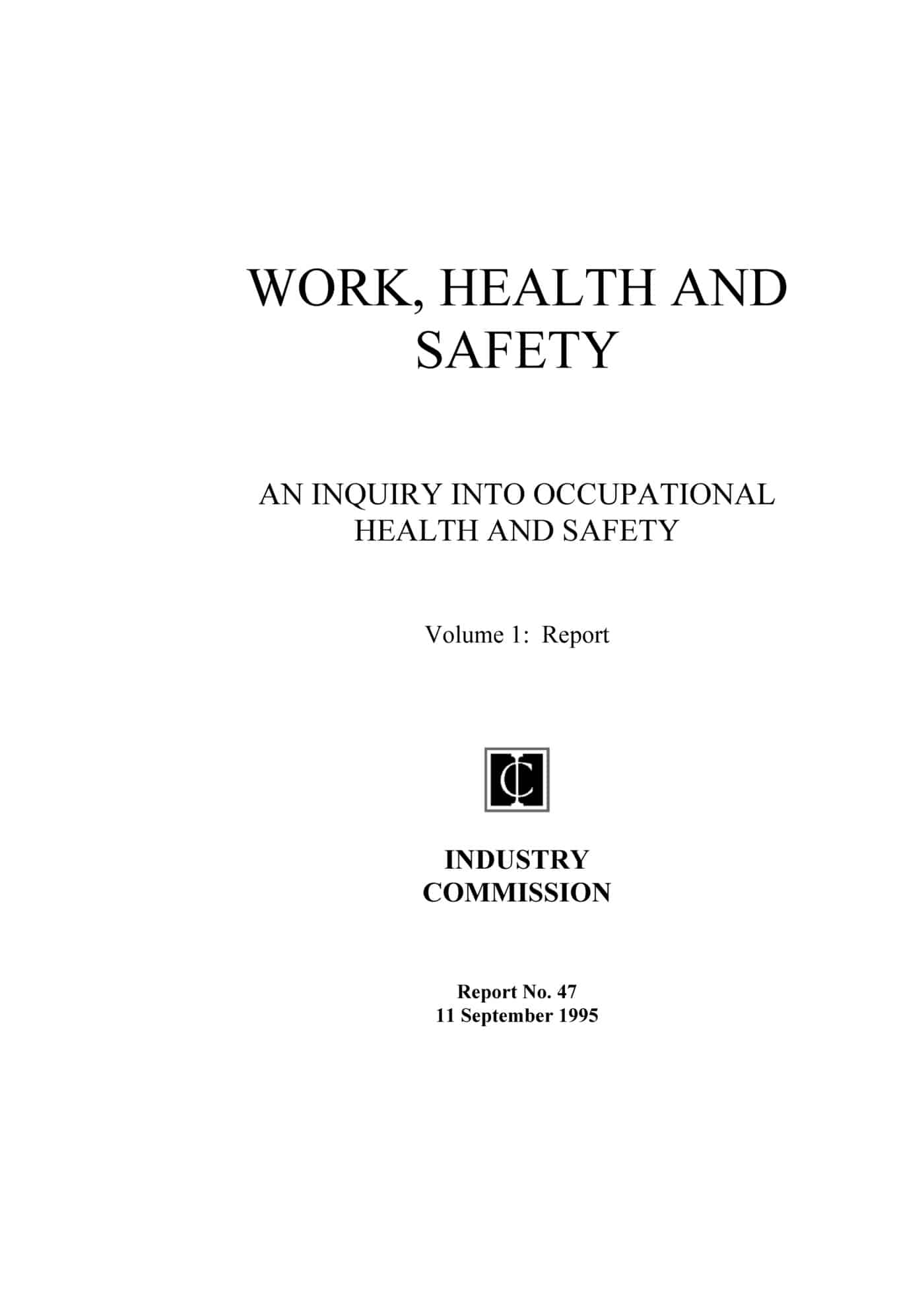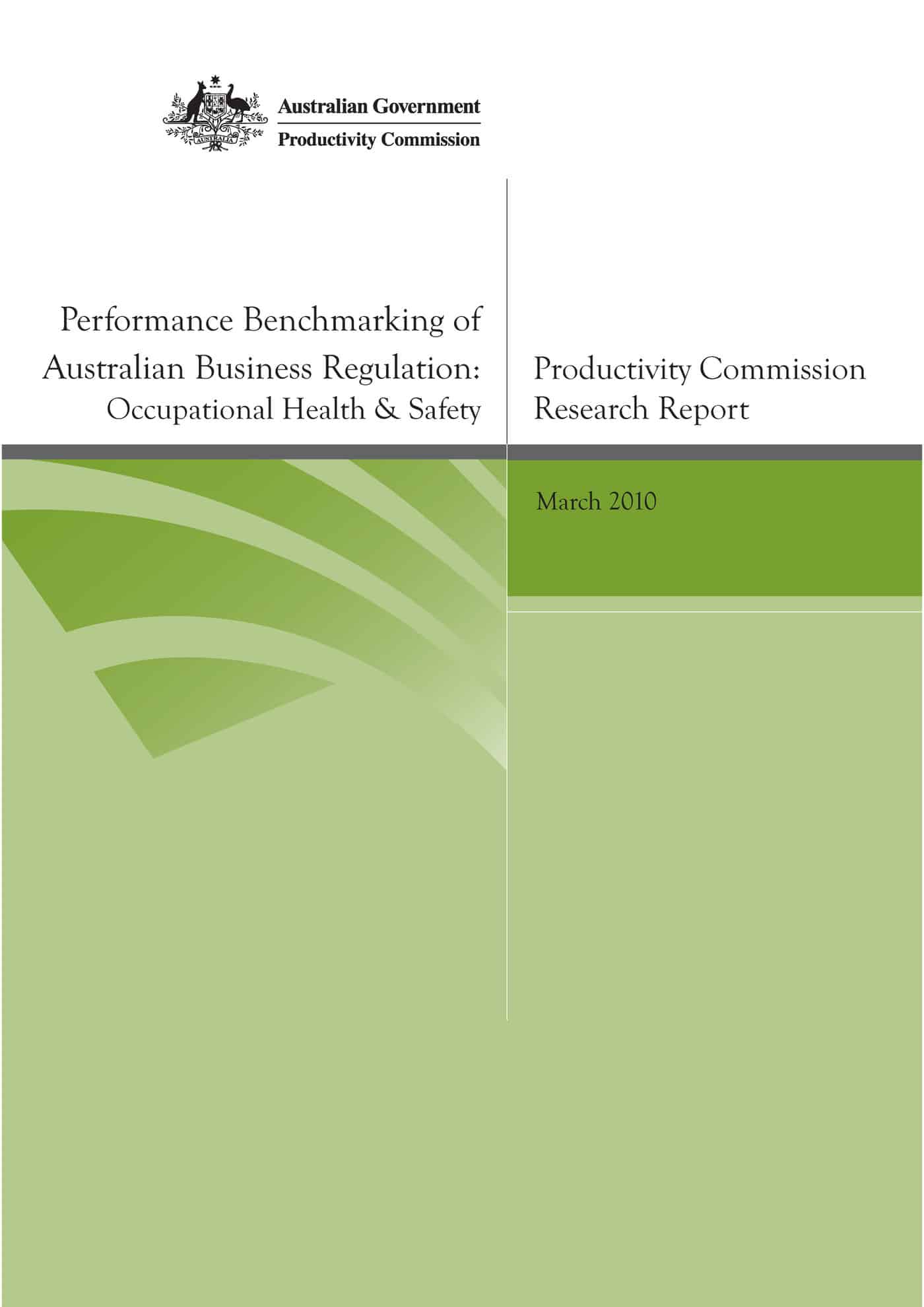 A lot of recent discussion of the impacts of workplace safety and productivity has centred on the Productivity Commission’s “Performance Benchmarking of Australian Business Regulation: Occupational Health & Safety” Report of 2010. However there was a 1995 report by the then-Industry Commission that can provide some broader context to the safety/productivity discussion. Recent evidence and research does not negate earlier reports and the safety/productivity debate should be considered over the longer time period, when there were different economic and political situations.
A lot of recent discussion of the impacts of workplace safety and productivity has centred on the Productivity Commission’s “Performance Benchmarking of Australian Business Regulation: Occupational Health & Safety” Report of 2010. However there was a 1995 report by the then-Industry Commission that can provide some broader context to the safety/productivity discussion. Recent evidence and research does not negate earlier reports and the safety/productivity debate should be considered over the longer time period, when there were different economic and political situations.
In 1995, the Industry Commission estimated the cost
“…to injured employees, their employers and the rest of the community of work-related injury and disease is at least $20 billion a year.” (page xiii)
(The March 2010 report stated the Australian Safety and Compensation Council
“…found the total economic cost of work-related injury and illness for the 2005-06 financial year to be $57.5 billion, representing 5.9 per cent of GDP.” Page 45)
The Industry Commission identified a ratio of costs associated with workplace injuries – 30-40-30:
“Around 30 per cent of the total cost
has to be met by injured workers and their families. Employers bear about 40 per cent in workers’ compensation costs, lost productivity and extra overtime. The community funds around 30 per cent, mostly in social security benefits and health subsidies.” (page xix)
On page 17 of the report, the Commission stated that the $A20 billion annual cost is
“…is significantly higher than the amounts covered by workers’ compensation premiums.”
The report quoted research from 1993 (Oxenburgh & Guldberg) that estimated
“…the indirect costs could be up to 3.5 times the workers’ compensation costs.” (page 17)
 Estimates of the status of workplace safety in Australia have predominantly been on the measure of workers’ compensation. Every time that metric is quoted, it is useful to remember that that the real cost will be higher.
Estimates of the status of workplace safety in Australia have predominantly been on the measure of workers’ compensation. Every time that metric is quoted, it is useful to remember that that the real cost will be higher.
Business owners and industry lobbyists should note that the Industry Commission quoted an example where:
“for injuries where workers return to work on full duties, employers incur about $230 in indirect costs for every $100 in the cost of workers’ compensation payments.” (page 21)
The most effective and sustainable method of reducing those direct costs is through improved safety management practices and the prevention of harm – the aim of OHS legislation since the Robens Report “shifted the focus of regulations from prescriptive requirements to process-and-outcome-related duties of care.” (Benchmarking Report 2010 page xv)
The Safety Institute of Australia’s (SIA) submission was quoted in the 1995 report stating:
“The major motivator for a corporation to introduce a prevention program would be cost reduction. This was indicated by chief executives who gave the maintenance of productivity and profits as the most important reason for taking accident prevention measures (Yann et al, 1990; and RMIT, 1992 ).” Page 108)
The SIA has rarely spoken on this link since that time and this corporate motivation is hardly ever heard of nowadays, but it existed at least 25 years ago and does so today.
Significantly, action on productivity was missing from SafeWork Australia’s National OHS Strategy 2002-2012 , although the inter-relationship was established well before the national strategy was written. The 2012-2022 strategy mentions productivity only briefly even though the strategy is supposedly aimed at establishing “Healthy, safe and productive working lives”. This is a surprising omission that excludes Safe Work Australia from much of the productivity debate.
In the development of the recent national strategy, one of the 2011 Safe Work Australia workshops in Townsville specifically listed productivity as significant:
“Ensure that safety and productivity are intertwined; recognise that leadership is the connecting link.” (page 30)
One of the scopes of Safe Work Australia’s consultative roadshow was:
“Safety Leadership and Organisation Culture: Safety leadership generates organisational cultures that view safety and productivity of equal importance, validated by the attitudes, beliefs, perceptions and values of the workforce.” (page 10, emphasis)
Australian OHS advocates talk about good safety management and improved productivity recognised by both the Industry Commission and Productivity Commission over many years but they fail to engage in the current debate and will, again, miss a major opportunity to use the strong economic evidence of the government commissions to educate or remind all levels of Australian business that by allocating money and resources to safety management, businesses will have a more productive workforce and reduce direct and indirect costs of injury and illness.
For those who want to look more closely at the issue of productivity and workplace safety, Dr Maurice Oxenburgh’s and Pepe Marlow’s paper, on the World Health Organisation website, entitled “The Productivity Assessment Tool: Computer-based cost benefit analysis model for the economic assessment of occupational health and safety interventions in the workplace” is well worth reading.

Quality is indeed the key word here.
Quality of management to ensure that WH&S practices are being adhered to correctly.
I have seen committee situations where stats are kept to a minimum by \’gagging\’ committee members, in order to perpetuate a \”nothing to see here- aren\’t our stats great, therefore, our systems are working\” approach to reporting.
We can have all the safeguards in place for a safe environment, yet, this can quickly be unravelled by simple laziness, at all levels.
Oh so true and so relevant today even more so in dubious economic times. Apart from getting a safety model that reaaly delivers the expected outcomes and empowering all levels of business to understand the implications and work with it, the biggest cause of safety being where it is is really what this article describes. too often safety is put in a straight jacket or accepts being put in a straight jacket, whereas they should really be working hand in hand with Quality as both being key attributes of the business that contribute to a positive and improved outcome for all.
Need to get on board – more major overseas companies are putting providers through the hoops to demonstrate a positive culture and not just by words in docs either, but actually requiring audited stats on safety performance to consider before contracts are given.. Safety has to help itself as a profession and use all available avenues and info to improve its role and reach.
The corporate pot of money where-ever you are is still the same size so if you are going to budget and seek more it means it will come out of someone else\’s budget and they wont be happy about that.
Use the information at your disposal to demonstrate positive gains for those parts of the business as well and become a core integrated part of the business to project positive improvement or cost benefits in all areas, linking it to a quality approach.
Forget the \’safety is our first priority\” line which most companies trot out. Just look at how the courts dealt with AMCOR over that in 2012. Who wants a directed notation and order by the court to have to be pasted on the company web site for up to 3 years?? Companies first priority is to make a profit otherwise it ceases to exist and everyone including safety is out of a job, so let\’s work smarter, use all info and data and really make a change both in our companies and in the bottom line of safety relating to peoples lives and well being.
Another valuable read is The Risk-Based Framework for Safety Investment in Construction Organisations by Hallowell, Matthew R (2011) available on the ASCE webpage, which tests a cost benefit analysis model for business to assess proposed OHS strategies. A simplied version for small businesses would also be a useful.